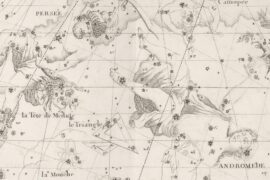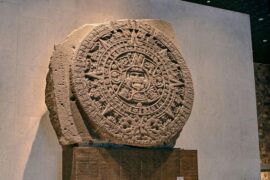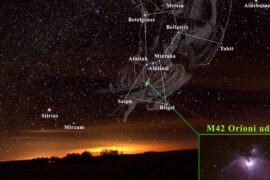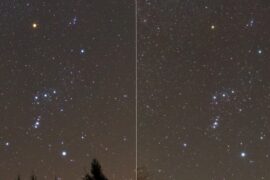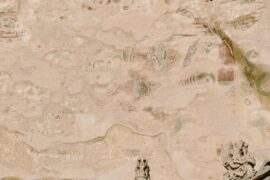As one of the twelve zodiac constellations, Aries is one of the most popular groups of stars in the night sky. Locating it without using a star map can seem a bit tricky because it doesn’t have any stars that stand out too much.
Thankfully, we have a simple method that will show you how to find the Aries constellation quickly. Anyone can learn to use it and it will even help you to recognize some of the other sets of stars in its vicinity.
What is Aries?
Aries is one of the original 48 constellations Greeks recognized in the sky. It is also part of the 12 constellations that make up the zodiac belt. The zodiac belt is an imaginary ring of stars that are more or less lined up with Earth’s orbit.
Aries represents the figure of a charging ram. Its name comes from the Latin word for ram.
It is also one of the simplest constellations as it is only formed by 4 stars in its original representation. A more modern way to “draw” the ram includes 5 other stars for a total of 9.
These are the stars that conform Aries and that you will learn to recognize once you learn how to locate this constellation.
| Proper Name | Designation | Visible Magnitude | Distance (light-years) |
| Hamal | Alpha Arietis | 2.01 | 66 |
| Sheratan | Beta Arietis | 2.64 | 60 |
| Mesartim | Gamma Arietis | 4.62 | 164 |
| Bharati | 41 Arietis | 3.61 | 159 |
The brightest star in Aries is Hamal. It will probably be the first star in it you will learn to recognize.
When to find the Aries constellation
Aries is visible from March to February. The best time to view it is during the month of December when it crosses the meridian.
Between March 20 and April 21 Aries completely hides behind the Sun. In astrology, during this period it is said that the Sun is in the house of Aries.
The constellation is visible between the latitudes of +90° to -60°. That means you can see it from Argentina, and all the way to the North Pole.
The only place on Earth where Aries is not visible at any point of the year in Antarctica.
How to find Aries
Ok. It is time to learn the method that will show you how to find the Aries constellation in the night sky. It requires no telescope or help from any other device. All you need is your eyes and nice weather.
We have detailed the method in the following infographic. You can find a more detailed explanation for each step below.
Here are the easy steps to locate our target constellation. If for some reason you can’t achieve one of the steps, not everything is lost, skip to the next section where we will tell you what to do then.
Step 1: Locate Orion
We are going to start our (very fast) quest to find Aries by using one of the most recognizable constellations as a reference. We are talking about Orion.
If you have ever looked at the sky and saw three stars very close to each other forming a straight line, you have seen Orion. Orion is very easy to spot, especially during the Fall and Winter months so we are going to use it as our starting point.
Simply look for Orion’s belt (the three stars mentioned above) in the sky, once you have them, proceed to the next step.
Step 2: Find Taurus
Extend the imaginary straight line that is formed by Orion’s belt in the direction of the star that is “above” the other two.
Follow that line with your eyes and it will not take you long to see a very bright star that almost crosses it exactly. This star is named Aldebaran or Alpha Tauri and it is the brightest star in the Taurus constellation. Congratulations, you have found Taurus!.
Step 3: Locate the Pleiades
Keep going in the same direction of the line you previously “traced” from Orion.
You should see a group of seven stars grouped very very close to each other. If the sky conditions are not that great you might only see it as one single star. Check out step 3 in the infographic so you can estimate how far it should be. The illustrations are approximately scaled to the real distances you will see.
This group of stars is called the Pleiades, named after 7 sisters in Greek mythology.
The Pleiades are still technically part of the Taurus constellation although they are separate from the main shape of the bull.
The Pleiades is one of the most famous asterisms. An asterism is a group of stars that isn’t officially a constellation, like the big dipper or the northern cross.
Step 4: Finally find Aries
It is time. Keep going in the same direction as all the previous steps, but without following the inclination. Aries is almost right next to the Pleiades as seen in the illustration.
The brightest star in Aries, Hamal, is hard to miss if you have made it to this point. It is located at about the same “height” as the Pleiades.
Once you locate it, you are done. Congratulations, you found Aries!
What if I got lost in any of the steps?
Aries is a dim constellation. None of its stars are super bright and its area is smaller than average.
It is possible to miss it even using this method, especially if the weather or light pollution conditions in your location are not helping.
Don’t worry though, there are other ways to find a constellation, but you will need some equipment, let’s start with the easiest one.
How to find Aries using your smartphone
When it comes to finding things on Earth, a map is always helpful. The same holds true for the stars.
A star map is an app that you can download to your phone that will grab your GPS location and will show you a map of the stars and other objects that are right above you so you can recognize them.
All the good star maps will include a search feature where you can simply enter the name of the constellation you are looking for and it will show you the direction you need to be looking at using your phone’s gyroscope and compass.
My favorite star map app due to how simple (and free) it is is Sky Map. Unfortunately, it is only available for android. On iOS I like Sky Safari, which is only $2.99.
If you are just getting into astronomy, a star map might just become your new favorite app.
How to find more constellations
Aries – Taurus – Gemini – Cancer – Leo – Virgo – Libra – Scorpius – Saggitarius – Capricornus – Aquarius – Pisces
Enjoyed this article?
Get daily 10-minute PDFs about astronomy to read before bed!
Sign up for our upcoming micro-learning service where you will learn something new about space and beyond every day while winding down.



